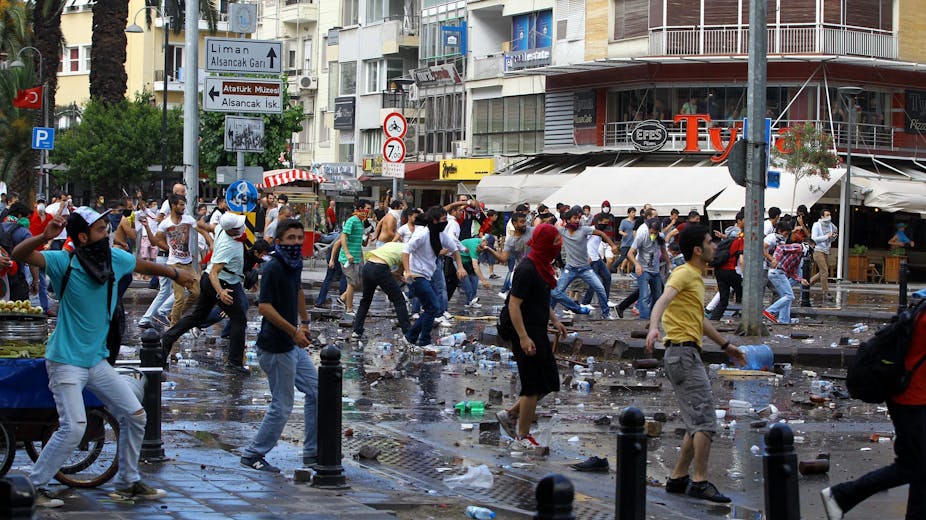The ongoing protests across Turkey, stretching from May 28, show there is ample evidence of a flourishing culture of democracy in the country. They also highlight a worrying counter trend.
Last week, the Turkish government announced a plan to build a shopping mall on Gezi Park, one of the last green public spaces in Istanbul’s cultural and political hub, Taksim. This is one of a number of recent public projects and announcements perceived by many residents to be part of the AKP’s conservative agenda to curtail people’s freedoms and choice.
The movement against the demolition of Gezi Park was started by a small organisation called the Taksim Platform. They call for transparency from decision-makers and seek the opportunity for citizens to have input into the design of public space. They work under the assumption that the fundamental principles of participatory democracy apply.
In the wake of the Arab Spring protests, many commentators hailed the “Turkish model” as a system of governance to which Arab states should aspire. Turkey is a modern, secular state, with a supposedly sound democratic framework, run by the conservative Justice and Development Party (AKP). But just how democratic does the “Turkish model” appear now?
From this seed a larger movement sprouted
Several thousand protesters gathered in the park to oppose this development, creating what one demonstrator described as a “festival-like atmosphere”.
Their very activism is testament to a thriving democratic culture in Turkey.
On the evening of the 30th, an estimated 5000 protesters had gathered. One protester said that the:
…so-called “urbanisation”, the recent alcohol restrictions, the Reyhanlı incident, the Uludere massacre, HES projects, nuclear plants and every move against human rights and living space was symbolised by that park.
At 5am on May 31, some 200 protesters remained in the park. Police surrounded the park, blocking off all the exits, and began to fire gas shells at the protesters. Rubber bullets, pepper spray and water cannons were also used. The demonstrators had nowhere to run.
An image of a young woman in a red dress, doing little more than clutching her tote and being sprayed in the face with tear gas, quickly circulated through social media. She became one of the first symbols that sparked a far broader movement than the government anticipated.
Public anger and mass demonstrations have since ensued throughout the entire country. Thousands of citizens across 67 cities have taken to the streets in protest, despite chemicals, violence and arrests being used against them. They scream slogans such as “Give us more tear gas” and “The people won’t yield to you”, amid their calls for Turkish prime minister Recep Tayyip Erdoğan to step down.
Initially the government chose to ignore the protests, seeing them as mere “provocations”. On Friday, Erdoğan remained unmoved on the demolition of Gezi Park, and announced that the project would go ahead, “no matter what [the demonstrators] do”. On Saturday, Erdoğan called for an immediate end to the protests. On Sunday, he said in a speech:
They call me a dictator…if they liken a humble servant to a dictator, then I am at a loss for words.
The demonstrations have brought at least one tangible result, as senior Turkish officials have conceded to abandon the project in Taksim.
Yet the streets are still full, even through the night, and police continue to use inordinate levels of violence.
What does this mean for Turkey’s “democracy”?
This week’s major popular unrest has not been witnessed in Turkey since the 1980s, a period that ended with a military junta. Noam Chomsky, a respected commentator on Turkish affairs, said:
The reports of the past few days are reminiscent of some of the most shameful moments of Turkish history, which, it seemed, had been relegated to the past during the progress of the past years.
Though democracy has progressed in recent years in Turkey, the events currently unfolding on the streets should be seen as the tipping point of a significant and smouldering indignation. Thousands of journalists, intellectuals and activists flounder under lock and key in the country. Arbitrary arrests and torture are commonplace.
The use of chemical weapons by a government against innocent citizens may be characterised as nothing less than authoritarian. No “humble servant” takes up violence against those whose interests they genuinely represent and serve.
Is this the “Turkish model”, the sound democratic state, to which so many commentators say the Arab World must aspire? Is this Syria’s democratic neighbour, from whose book Syrian president Bashar al-Assad must take a leaf?
We should not delude ourselves as the Turkish government appears to be doing. The spirit of Turkish democracy is not in the Grand National Assembly in Ankara. She is wearing a red dress, standing on the last green skerrick in the heart of Istanbul, while being tear-gassed for her care.

